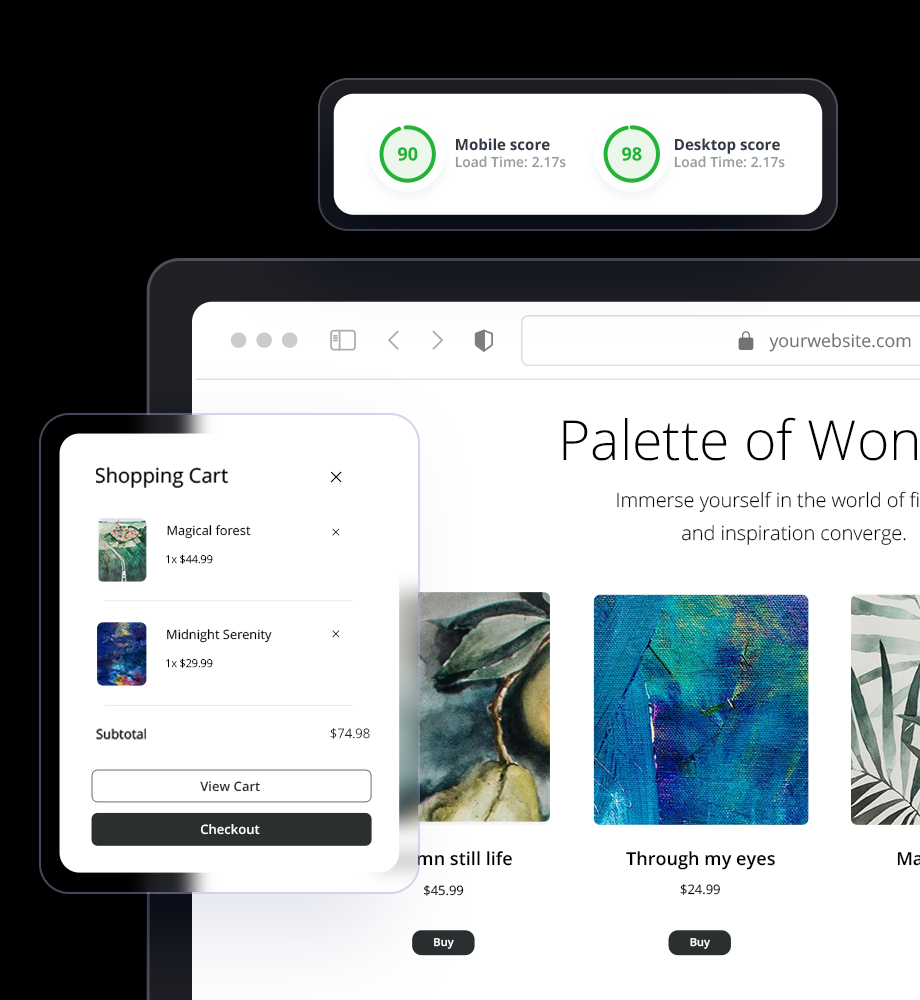You might be really nervous about turning your crafts into a business. Maybe you’ve heard “your resin earrings are so cute!” but no one actually says, “I want to buy that.” Or you’ve thought about setting up a store, but the fear of wasting time and money keeps holding you back. That hesitation is totally normal.
This guide is for you if you’ve got talent, passion, and a growing stash of supplies, but aren’t sure how to turn it into income. We’ll walk through how to start a craft business from home, avoid potential overwhelm, and balance it all with your life and energy. You don’t need to go full-time. You don’t need to have it all figured out. You just need to start.
Start small: Test the waters before going all in
Starting a craft business lets you fund your hobby, share your work with others, and earn on your own terms. You might be looking to build a full-time income or just make your creative passion pay for itself. In both cases, there’s room for every pace and purpose.
As we mentioned already, don’t push yourself to launch a full-blown brand on day one. Many successful crafters started by testing one product on one platform, with what they already had. One simple and low-stress way to approach it is like this:
- Use what you already have: No need to bulk order or spend big upfront.
- Start with one product: Pick the craft you enjoy most and that gets compliments.
- Open a simple shop: Use referral links to lead to your shop .
- Skip full branding for now: A clear name, maybe a logo, and a good photo are enough.
- Post one photo on social: Show what you made and why.
How to start a craft business: Step-by-step guide
Starting a craft business doesn’t require a perfect plan, a warehouse of supplies, or hundreds of dollars. The hardest part is putting yourself out there. So, let’s go step-by-step and see how to launch with confidence.
Step 1: Choose your niche
Your niche is the heart of your craft business. Think about what you want to be known for and what people are likely to buy, not just what you can make. A mistake most crafters and small business owners make is selling everything.
Instead, start with focus. A clear niche helps you stand out and makes it easier for buyers to remember, and recommend, you. So, how do you find your niche? Think about a few areas:
- List your favorite crafts: What do you enjoy making the most?
- Check demand: What gets the most compliments or likes when you share?
- Spot patterns: Is there a theme in your materials, style, or audience?
- Look at the market: Are there too many people selling it already, or room to stand out?
Even if you work across multiple mediums (like resin, vinyl, or painting), your niche could be about style or audience, not materials. For example, you can say that you create sentimental resin jewelry for moms, or design cozy gifts for introverts and book lovers. The specific you are, the better.
Don’t worry, your niche can evolve with time. It’s not something you are stuck with forever. It’s just when you start with a niche, you get friction faster. Once you build an audience, you can branch out with confidence.
Step 2: Build your brand
Branding is one of the most overlooked parts of how to start a craft business, but it makes a huge difference. As we already said, you don’t need a perfect brand to start, but having a consistent look and feel helps you build trust and get remembered.
By “brand” we don’t mean just the logo, but how your craft business feels in general: your product photos, the colors you use, the packaging you go for, and much more. If people connect with you through those elements, they’ll be more likely to trust and buy from you. So, let’s focus on key elements that matter:
- Name: Choose something clear, memorable, and relevant to what you make. You can use 10Web’s Free Business Name Generator to give you some ideas.
- Style: Select 2–3 colors, 1–2 fonts, and a tone of voice (e.g. playful, earthy, minimalist). This is an important step, and there are tools to help you. We’ll discuss them below.
- Photos: Use natural lighting, neutral backdrops, and props that match your vibe.
- Story: Share why you craft, how you started, and what your products mean to you.
After you choose your name, you should have some basics like colors, fonts, and preferably a simple logo ready. Hiring a designer can cost hundreds. Doing it yourself can eat up days. That’s why new sellers love tools like 10Web Logo Maker, a free tool that helps you create a professional logo with AI in minutes with no design skills.
You just describe your business, pick a style, and instantly get logo options for your brand. You then can adjust everything (colors, fonts, icons) until it feels just right. Once you’re happy, you can download your full brand kit, including:
- High-res logo files (for Etsy, social, packaging)
- Matching colors, fonts, and templates
- A cohesive look across all your social platforms
Tip to keep in mind: Keep your first logo simple and clean. You can always evolve it as your business grows.
Step 3: Create your first product listing
Before you write a business plan or register your LLC, just get one product live. Posting a real listing, even if it’s simple, is one of the most powerful confidence-builders. It forces clarity: What are you selling? Who’s it for? What does it look like? Once it’s out there, you’re no longer “thinking” about starting, you’re doing it. Here’s what you need:
- One product you enjoy making (and people respond well to)
- A short description that highlights what it is and why it’s special
- A clear photo with good lighting, neutral background, real-life setting if possible
- A fair price based on materials and time (don’t worry, we’ll cover pricing soon)
As for where to post it, it depends on where you already have some audience (if you do), and where your audience can be found. It’s usually easy to start with Etsy, Facebook Marketplace, or even an Instagram post. We’ll go into detail about the online presence in Stage 2.
With photos, try to add your brand vibe. If you’re going for “cozy”, photograph it with a blanket and a candle. If you’re targeting modern, keep it contrasty. Just make sure to avoid cluttered backgrounds and show the product in context (e.g. mug on a table, earrings on a friend), and you’ll be good.
Step 4: Set up your business legally
Once you’ve listed your first product and you’re feeling more confident, you can make things official. Don’t let this part scare you off. Think about the benefit: if you’re planning to grow, protect your finances, or look more professional, setting up your business structure is a smart move.
| Type | Best for | Cost & setup | Pros | Cons |
| Sole proprietorship | Testing or small-scale sellers | Free to minimal ($0–$50) | Easy setup, minimal paperwork | No legal separation. You’re personally liable. |
| LLC (Limited Liability Company) | Growing businesses or sellers with risk (e.g. sharp tools, kids’ products) | Varies by state ($50–$300+) | Protects your personal assets, more legit in buyers’ eyes | Slightly more admin and filing costs. |
Note: While this isn’t legal advice, it’s based on extensive research and what’s worked for thousands of craft business owners. Always double-check requirements in your state or consult a professional if you’re unsure.
Other basic legal steps:
- Register your business name (if using something other than your own name)
- Check for local business licenses or seller permits, especially if you sell in person or collect sales tax
- Get an EIN (Employer Identification Number) from the IRS if you’re hiring help or opening a business bank account, free and easy online
Step 5: Open a business bank account and track your profits
This is where the overwhelm can hit you once again, but that’s not as scary as it may seem. However, you do need to separate your craft income from your personal money, even if you’re just making a few sales. It keeps things clean, builds credibility, and makes tax season way less stressful.
Even a basic checking account under your name works fine at first. There’s no need for a fancy “business” account right away. What matters is to keep business income & expenses separate, only use it for craft-related transactions, and connect it to your Etsy, Shopify, or PayPal payouts
Most banks will ask for your EIN (easy + free from the IRS) and your business name if it’s different from your own. So, have them ready.
Track your income and expenses
Even if you’re not making much yet, start building the habit. It helps you see what’s profitable, avoid surprise at tax time, and make smarter decisions as you grow. Here’s what to track:
- Craft sales (Etsy, in person, social)
- Materials and supplies
- Packaging and shipping
- Software/tools (like website hosting, Canva, domain names, etc.)
If you’re serious about how to start a craft business and keep it stress-free long-term, tracking your income and separating finances early is one of the best habits to build. As for tools, you can either use a simple spreadsheet (download free budget templates online for help), or use apps like Wave or QuickBooks Self-Employed. Those work great for beginners.
Step 6: Build your online presence and start selling
By Step 3, you’ll already have your product listed somewhere, but that’s just the beginning. Social platforms like Instagram or Etsy are great for discovery, but they’re also unpredictable. One day you’re visible, the next day the algorithm shifts and you’re not. That’s out of your control, and it shouldn’t be your main foundation.
Let’s not add extra stress. We want a steady, natural growth path. When someone discovers you on social media, you don’t want them to forget you the next day. You want to guide them to a place that’s always yours, your website.
Think of your website as a calm, welcoming hub. It doesn’t rely on trends or algorithms. It’s where you can:
- Share your work
- Build a tiny community
- Sell directly without middlemen
- Post behind-the-scenes updates or tutorials with a blog
Here, too, we don’t want any extra anxiety, and there are great options that let you build your beautiful website without hiring a designer/developer or learning to code.
Use AI to build your site stress-free
The idea of building a website might sound overwhelming. You’re already assuming that you will either need to hire an agency, a developer, learn how to code yourself, or spend your evenings tearing your hair out over generic templates. That’s not necessarily true.
You don’t need to start from scratch, or learn design. Tools like the 10Web AI Crafts Shop Website Builder take what you already know about your craft and turn it into a clean, ready-to-share website. You just answer a few questions, and the AI builds the structure for you.
It works especially well for crafters because it:
- Sets up your homepage, product pages, and branding automatically
- Lets you tweak things easily with drag-and-drop, or just by chatting with the AI Co-Pilot
- Comes with hosting, backups, and built-in store tools so you don’t have to worry about the tech stuff
- Has easy product page edits, inventory management, payment options, and everything you need for your ecommerce shop
If you’ve already used the 10Web Logo Maker, your basic site layout is already waiting. If not, you can try it in three quick steps:
- Describe your business: What you make, who it’s for, and the kind of style you like
- Let AI build it out: You’ll get a fully structured website with all the essentials
- Make small edits: Adjust the layout, fonts, or sections until it feels like you
In a few minutes, you’ll have a calm, reliable place to send people, one that grows with you as your business does.
Wait!
Your online store
is a click awayYour online store
is a click away





Step 7: Get your crafts in front of the right people
By now, you’ve got something most beginners don’t: your own website. That means you already have a place that’s fully yours, where people can browse your work, learn your story, and buy directly from you without distractions or fees. Now it’s time to get people there.
Visibility is often the biggest blocker to starting a craft business and growing it. At this stage, we’re not choosing Etsy, Pinterest, or Instagram. You’ve already made your home. These other platforms are just doors that help people find it. The goal here is to build visibility in a way that fits your life and your craft.
Let’s take a look at a few discovery channels to drive traffic to your site:
| Channel | Effort | Control | Best for | Strategy |
| Your website | Low to medium (setup, then easy) | Full control | Long-term brand, repeat customers | Keep all your traffic, profits, and ownership. Link to it everywhere. |
| Etsy | Low | Limited | Quick early sales, search traffic | Add 1-2 listings with links to your site for full collections. |
| Craft fairs / in-person | High (logistics) | Full control | Local audience, feedback | Use a simple printed card with your website and a QR code. |
| Medium | Limited | Visual storytelling, process | Post regularly, link to your website in bio or stories. | |
| Medium | Limited | Tutorials, seasonal crafts | Great for pinning blog posts or collections from your site. |
Think of everything else (Etsy, social media, fairs) as satellites. They pull people in, but your site is where they buy, subscribe, and return. This way you’re not worrying about listing fees, design limitations, or algorithm games. You control the experience from first click to checkout.
Step 8: Price your crafts for profit
Let’s talk about something that makes a lot of creative people freeze: putting a price on your work. A lot of people don’t want to charge too much so as not to scare people away, but underpricing is one of the fastest ways to burn out. Let’s at least make sure your prices cover your costs, honor your time, and leave room to grow.
Start with a super simple formula:
(Materials + Time + Extras) x 2 = Starting price
Let’s break that down:
- Materials: What you spent to make it (e.g. clay, paint, resin, thread)
Time: Multiply the hours it took by your ideal hourly rate (start with $15–$20/hour) - Extras: Packaging, shipping, Etsy listing fees if applicable
You multiply it all by 2 to leave room for profit (yes, you deserve it), future discounts, and wholesale/bulk pricing later.
Let’s review an example. You made a handmade candle with $4 worth of materials, in one hour (worth $20), and spent $2 on labeling and packaging. So, your total cost is $26, and your starting price should be $52. If that feels high, you can test a price range (e.g. $48–$52) and adjust later based on interest.
Don’t be scared to be stuck with the same price. It’s not permanent. You’re experimenting. Start where you feel comfortable, but don’t price just to “be affordable.” Once you have growing demand, you can raise prices slowly.
Your first step matters most
If you’ve made it this far, you’re not just learning how to start a craft business, you’re doing it. Even if you’re unsure, every post, every product, and every share builds your momentum. Start small. Build gradually. Grow proudly. So here’s your one task today: Post your first photo, even if it’s not perfect. The rest will come.
When you’re ready to build a home for your craft business that’s truly yours, where your story, products, and passion all live in one place, tools like 10Web’s AI Website Builder are here to help you launch fast and grow at your own pace.
Your craft deserves to be seen, and you deserve to feel proud of putting it out there.
FAQ
How do I start a craft business from home? How profitable is a craft business? Do I need an LLC to sell crafts? What is the most profitable craft to sell? I’m scared to put myself out there. What should I do? What if nobody buys anything? How do I know if I’m good enough?












